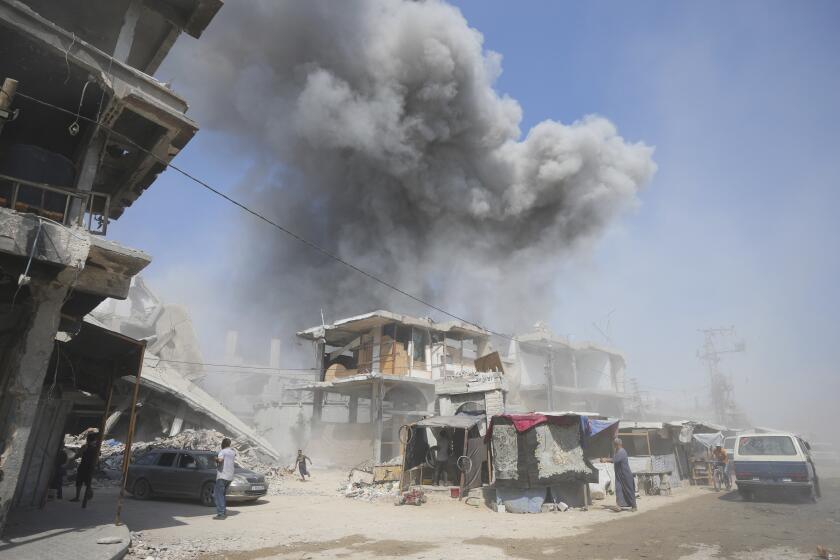Soviet Economy Advancing to the Rear
The miners’ strike that began in Siberia’s Kuznets Basin before spreading this week to the Ukraine is by far the biggest in recent Soviet history. But it is hardly an isolated incident.
In recent months, labor problems have sprung up in Leningrad, Eisk, Klaipeda, Vorkuta and dozens of other Soviet cities. Nor is the unrest confined to urban areas. Besides the coalfields of Siberia and the Ukraine, strikes have also been reported on collective farms throughout the Soviet Union.
There is a certain irony in the fact that Soviet workers have turned to confrontation just as President Mikhail S. Gorbachev has begun to press for liberal reforms. Yet the reasons for this are several.
Work stoppages were rare in the past because participants faced harsh reprisals. Dissatisfaction was expressed through absenteeism, low productivity and labor turnover. In the glasnost era, with Soviet newspapers printing daily the accounts of corruption in high places, strikers stand a good chance of being heard. And some even get what they want.
S. Krodov, correspondent for Literary Gazette, concluded his story about a collective farm strike near the Crimean city of Bakhchisaray with a ringing indictment of “the marionette leadership, corrupted by repressions against dissenters” and praised strike organizers who “refused to quit, as did so many before them, but continue to fight for justice at home.”
Labor unrest in the Soviet Union offers us an unusual insight into the human cost of the current economic reforms. New rules placed a heavy burden on managers to show a profit, without offering them the requisite freedom to secure supplies and market their products. These constraints forced some authorities to cut salaries and raise production quotas, leaving workers to hold the bag.
In Kuznets, metal glazers staged a slowdown to dramatize the hardships they faced after they were ordered to speed up their production. In Eisk, bus drivers went on strike after they discovered that their monthly pay was cut without much warning from the authorities, who simply told them that the rates had changed and now they would have to work harder to earn their wages.
Soviet managers have their own horror stories to tell about “self-financing,” as the new Soviet economic system is called. They are particularly unhappy about the arbitrary pricing system. For instance, textile industry managers are allowed to bring higher-priced goods to the market and earn larger profits, even if there is no visible increase in quality. In the coal mining industry, by contrast, prices are fixed by the state and stay low, while production costs continue to rise, leaving workers few chances to make headway.
Potentially even more troublesome is the prospect of unemployment, which looms ever larger since Gorbachev unleashed his drive to increase productivity and cut down to size the managerial staff. According to the Soviet journal Sociological Research, the Dagestan Autonomous Republic has 170,000 unemployed. The Republic of Byelorussia projects that 200,000 workers will lose their jobs in the next few years.
Laid-off workers are entitled to alternative job offers, but this provision masks an ugly reality. Workers transferring to new jobs may lose the housing provided by old employers and, in some cases, a city residence permit. The forced transfer is usually accompanied by an income loss.
No wonder Soviet workers began to form their own labor organizations, such as the Labor Initiative Club at the Krasnaia Zaria factory in Leningrad, to challenge the official trade unions as the spokesmen for workers’ welfare. More importantly, workers are beginning to press for political reforms. Miners in Siberia and the Ukraine now want to revise the constitution, have greater control over the operation of the mines, cut the bureaucracy down to size and reverse the disastrous ecological problems in their regions.
Gorbachev may have sought to combine the best of socialism and capitalism, but for the time being he has achieved pretty much the opposite: Inflation, job insecurity and labor unrest are now added to the familiar list of Soviet economic woes--long lines, pervasive shortages, goods of shoddy quality. The social contract that has bound the party and the people for decades--”we keep in you in food and clothes, you don’t ask questions and let us govern”--is clearly unraveling.
Let us not forget, however, that Gorbachev’s program includes “democratization” as one of its goals. This is where he has something to show for his efforts. The case in point is the outline of the new labor legislation published in May, which provides for independent trade unions and acknowledges a limited right to strike.
If the new Soviet legislature passes this law, we may yet see current reforms pushed beyond the half-measures envisioned by Gorbachev. Indeed, this might be the best hope left for the Soviet economy.
More to Read
Sign up for Essential California
The most important California stories and recommendations in your inbox every morning.
You may occasionally receive promotional content from the Los Angeles Times.






